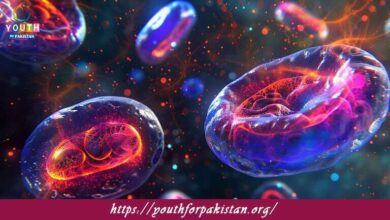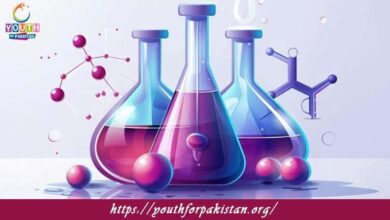11th Class Chemistry Chapter 11 MCQs with Answers

Prepare for exams with Reaction Kinetics MCQs focusing on reaction rates, factors affecting rates, and rate laws. These Chapter 11 quizzes help 11th Class Chemistry students grasp key concepts effectively.
a) Chemical structures
b) Chemical properties
c) Reaction rates
d) Thermodynamics
The rate of a chemical reaction is defined as .
a) The change in concentration of reactants
b) The change in concentration of products
c) The change in temperature during the reaction
d) The change in pressure during the reaction
Which factor does NOT influence the rate of a chemical reaction?
a) Temperature
b) Concentration of reactants
c) Pressure
d) Molecular weight of the products
A reaction with a high activation energy will have a .
a) Fast reaction rate
b) Slow reaction rate
c) Constant reaction rate
d) No reaction rate
The collision theory is used to explain .
a) How reactions occur in the gas phase
b) How reactions occur in the liquid phase
c) How reactions occur in the solid phase
d) How reactions occur at the atomic level
The rate-determining step of a reaction .
a) Is the first step of the reaction mechanism
b) Is the last step of the reaction mechanism
c) Has the highest activation energy
d) Has the lowest activation energy
A catalyst increases the rate of a chemical reaction by .
a) Decreasing the activation energy
b) Increasing the activation energy
c) Changing the stoichiometry of the reaction
d) Consuming the reactants more rapidly
Which statement about enzymes is correct?
a) Enzymes increase the activation energy of a reaction.
b) Enzymes are consumed during the reaction.
c) Enzymes are specific for a single reaction.
d) Enzymes only work in acidic conditions.
The Arrhenius equation relates .
a) The rate constant and the temperature of a reaction
b) The rate constant and the concentration of reactants
c) The activation energy and the temperature of a reaction
d) The activation energy and the concentration of reactants
Which of the following statements is true regarding a first-order reaction?
a) The reaction rate is independent of the concentration of the reactant.
b) The reaction rate is directly proportional to the concentration of the reactant.
c) The reaction rate is inversely proportional to the concentration of the reactant.
d) The reaction rate remains constant throughout the reaction.
A second-order reaction has a rate equation of the form .
a) rate = k[A]
b) rate = k[A]^2
c) rate = k
d) rate = k/[A]
Which statement is true for a zero-order reaction?
a) The reaction rate is independent of temperature.
b) The reaction rate is independent of the concentration of the reactant.
c) The reaction rate is independent of the presence of a catalyst.
d) The reaction rate is independent of the reaction order.
The half-life of a first-order reaction depends on .
a) Initial concentration of the reactant
b) Activation energy of the reaction
c) Pressure of the reactants
d) Initial concentration of the products
The half-life of a second-order reaction depends on .
a) Initial concentration of the reactant
b) Activation energy of the reaction
c) Pressure of the reactants
d) Initial concentration of the products
The half-life of a zero-order reaction depends on .
a) Initial concentration of the reactant
b) Activation energy of the reaction
c) Pressure of the reactants
d) Initial concentration of the products
What is the order of a reaction if the reaction rate is directly proportional to the concentration of the reactants A and B?
a) Zero-order
b) First-order
c) Second-order
d) Third-order
The rate constant of a reaction depends on .
a) Temperature only
b) Concentration of reactants only
c) Activation energy only
d) Temperature and activation energy
A reaction with a negative rate constant is .
a) First-order
b) Second-order
c) Reversible
d) Not possible
What is the overall order of a reaction if the rate equation is given as rate = k[A]^2[B]?
a) Zero-order
b) First-order
c) Second-order
d) Third-order
What is the rate constant of a reaction with a rate equation of rate = k[A]?
a) k
b) [A]
c) k/[A]
d) [A]/k
What is the rate constant of a reaction with a rate equation of rate = k[A]^2[B]^2?
a) k
b) [A]
c) k/[A]^2[B]^2
d) [A]^2[B]^2/k
What is the rate constant of a reaction with a rate equation of rate = k?
a) k
b) [A]
c) k/[A]
d) [A]/k
A reaction is first-order with respect to reactant A and second-order with respect to reactant B. What is the overall order of the reaction?
a) Zero-order
b) First-order
c) Second-order
d) Third-order
A reaction is second-order with respect to both reactants A and B. What is the overall order of the reaction?
a) Zero-order
b) First-order
c) Second-order
d) Third-order
Which statement is true for a reaction at equilibrium?
a) The rate of the forward reaction is equal to the rate of the reverse reaction.
b) The rate of the forward reaction is faster than the rate of the reverse reaction.
c) The rate of the forward reaction is slower than the rate of the reverse reaction.
d) The rate of the forward reaction is zero.
The equilibrium constant (K
c) for a reaction is .
a) The ratio of the concentrations of the products to the reactants at equilibrium.
b) The ratio of the concentrations of the reactants to the products at equilibrium.
c) The sum of the concentrations of the reactants and products at equilibrium.
d) The difference between the concentrations of the reactants and products at equilibrium.
The equilibrium constant (K
c) for a reaction is 1. What does this indicate?
a) The reaction is at equilibrium.
b) The reactants and products are present in equal amounts.
c) The reaction has not reached equilibrium.
d) The reaction is not possible.
If the value of the equilibrium constant (K
c) for a reaction is greater than 1, it indicates that .
a) The reaction favors the products at equilibrium.
b) The reaction favors the reactants at equilibrium.
c) The reaction is not at equilibrium.
d) The reaction is not possible.
If the value of the equilibrium constant (K
c) for a reaction is less than 1, it indicates that
.
a) The reaction favors the products at equilibrium.
b) The reaction favors the reactants at equilibrium.
c) The reaction is not at equilibrium.
d) The reaction is not possible.
Which factor does NOT affect the equilibrium constant (K
c) for a reaction?
a) Temperature
b) Catalyst
c) Pressure
d) Initial concentrations of reactants and products
What does the value of the reaction quotient (Q
c) indicate in relation to the equilibrium constant (K
c)?
a) If Qc = Kc, the reaction is at equilibrium.
b) If Qc > Kc, the reaction favors the products.
c) If Qc < Kc, the reaction favors the reactants.
d) All of the above.
Le Chatelier’s principle states that when a system at equilibrium is subjected to a change,
the system will .
a) Stay at equilibrium
b) Shift to the left to form more products
c) Shift to the right to form more reactants
d) Shift in the direction that counteracts the change
Increasing the temperature in an exothermic reaction at equilibrium will cause the equilibrium to .
a) Shift to the left to form more reactants
b) Shift to the right to form more products
c) Stay at equilibrium
d) Not be affected
Increasing the pressure of a gaseous reaction at equilibrium will cause the equilibrium to
a) Shift to the left to form more reactants
b) Shift to the right to form more products
c) Stay at equilibrium
d) Not be affected
The presence of a catalyst affects the equilibrium position of a reaction.
a) True
b) False
A reaction that has reached equilibrium can be described as .
a) Not proceeding in any direction
b) Proceeding only in the forward direction
c) Proceeding only in the reverse direction
d) Proceeding in both the forward and reverse directions at equal rates
What is the relationship between the rate constant (k) and the activation energy (E
a) of a reaction?
a) As Ea increases, k increases.
b) As Ea increases, k decreases.
c) There is no relationship between k and Ea.
d) As Ea decreases, k decreases.
Which of the following statements is NOT true regarding a catalyst in a reaction?
a) Catalysts increase the rate of the forward reaction.
b) Catalysts decrease the activation energy of the forward reaction.
c) Catalysts are consumed during the reaction.
d) Catalysts provide an alternative reaction pathway with lower activation energy.
What is the unit of the rate constant (k) for a first-order reaction?
a) M/s
b) M^-1
c) M^-1 s^-1
d) M^-2 s^-1
What is the unit of the rate constant (k) for a second-order reaction?
a) M/s
b) M^-1
c) M^-1 s^-1
d) M^-2 s^-1
What is the unit of the rate constant (k) for a zero-order reaction?
a) M/s
b) M^-1
c) M^-1 s^-1
d) M^-2 s^-1
The rate constant (k) of a reaction increases with .
a) Decreasing temperature
b) Increasing temperature
c) No dependence on temperature
d) Decreasing concentration of reactants
The rate constant (k) of a reaction decreases with .
a) Decreasing temperature
b) Increasing temperature
c) No dependence on temperature
d) Decreasing concentration of reactants
Which statement is true regarding the rate of a chemical reaction?
a) The rate is constant throughout the reaction.
b) The rate is always faster in the presence of a catalyst.
c) The rate is independent of the temperature.
d) The rate can vary with time.
The reaction rate is expressed as the change in per unit time.
a) Pressure
b) Temperature
c) Concentration
d) Volume
In a chemical reaction, the transition state refers to .
a) The initial state of the reactants
b) The final state of the products
c) A state where the reaction is at equilibrium
d) A high-energy state between reactants and products
What is the role of a solvent in influencing reaction rates in solution?
a) Solvents decrease the activation energy of reactions.
b) Solvents increase the activation energy of reactions.
c) Solvents provide a medium for reactant molecules to collide.
d) Solvents are catalysts in many reactions.
In a reaction mechanism, intermediate species are .
a) The final products of the reaction
b) The initial reactants of the reaction
c) Formed during the rate-determining step
d) Stable throughout the reaction
Which statement is true about the activation energy of a reaction?
a) It is the energy difference between the reactants and products.
b) It represents the energy required to initiate the reaction.
c) It is always negative.
d) It is equal for all reactions.
The collision theory explains that reaction rate depends on .
a) The concentration of the reactants
b) The pressure of the reactants
c) The frequency and energy of collisions between reactant molecules
d) The volume of the reaction vessel
What is the effect of adding a catalyst on the activation energy of a reaction?
a) It increases the activation energy.
b) It decreases the activation energy.
c) It has no effect on the activation energy.
d) It depends on the specific reaction.
A reaction with a high activation energy will have a .
a) Fast reaction rate
b) Slow reaction rate
c) Constant reaction rate
d) No reaction rate
Which of the following is an example of an elementary reaction?
a) 2NO2 → N2O4
b) 2H2 + O2 → 2H2O
c) A + B → AB
d) 2H2O → 2H2 + O2
The Arrhenius equation relates .
a) The rate constant and the temperature of a reaction
b) The rate constant and the concentration of reactants
c) The activation energy and the temperature of a reaction
d) The activation energy and the concentration of reactants
What is the role of a catalyst in a chemical reaction?
a) To increase the concentration of reactants
b) To increase the temperature of the reaction
c) To provide an alternative reaction pathway with lower activation energy
d) To increase the pressure of the reaction vessel
What is the rate-determining step in a chemical reaction mechanism?
a) The step with the lowest activation energy
b) The step with the highest activation energy
c) The first step of the reaction
d) The last step of the reaction
What is the overall order of a reaction if the rate equation is given as rate =
k[A]^2[B]^2?
a) Zero-order
b) First-order
c) Second-order
d) Third-order
A reaction is first-order with respect to reactant A and zero-order with respect to reactant
B. What is the overall order of the reaction?
a) Zero-order
b) First-order
c) Second-order
d) Third-order
The rate constant of a reaction depends on .
a) Temperature only
b) Concentration of reactants only
c) Activation energy only
d) Temperature and activation energy
A reaction with a negative rate constant is .
a) First-order
b) Second-order
c) Reversible
d) Not possible
If you are interested to enhance your knowledge regarding Physics, Chemistry, Biology, and Computer please click on the link of each category, you will be redirected to dedicated website for each category.




